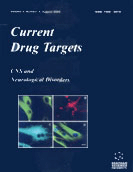Abstract
Receptor for advanced glycation endproducts (RAGE), a member of the immunoglobulin superfamily, is a multi-ligand, cell surface receptor expressed by neurons, microglia, astrocytes, cerebral endothelial cells, pericytes, and smooth muscle cells. At least three major types of the RAGE isoforms (full length, C-truncated, and N-truncated) are present in human brains as a result of alternative splicing. Differential expression of each isoform may play a regulatory role in the physiological and pathophysiological functions of RAGE. Analysis of RAGE expression in non-demented and Alzheimers disease (AD) brains indicated that increases in RAGE protein and percentage of RAGE-expressing microglia paralleled the severity of disease. Ligands for RAGE in AD include amyloid β peptide (Aβ), S100/calgranulins, advanced glycation endproductmodified proteins, and amphoterin. Collective evidence from in vitro and in vivo studies supports that RAGE plays multiple roles in the pathogenesis of AD. The major features of RAGE activation in contributing to AD result from its interaction with Aβ, from the positive feedback mechanisms driven by excess amounts of Aβ, and combined with sustained elevated RAGE expression. The adverse consequences of RAGE interaction with Aβ include perturbation of neuronal properties and functions, amplification of glial inflammatory responses, elevation of oxidative stress and amyloidosis, increased Aβ influx at the blood brain barrier and vascular dysfunction, and induction of autoantibodies. In this article, we will review recent advances of RAGE and RAGE activation based on findings from cell cultures, animal models, and human brains. The potential for targeting RAGE mechanisms as therapeutic strategies for AD will be discussed.
Keywords: receptors, amyloid-beta peptide, proteins, amphoterin, neuroinflammation, neurodegeneration, cerebral amyloid angiopathy, alzheimers disease
Current Drug Targets - CNS & Neurological Disorders
Title: Preventing Activation of Receptor for Advanced Glycation Endproducts in Alzheimers Disease
Volume: 4 Issue: 3
Author(s): L- F. Lue, S. D. Yan, D. M. Stern and D. G. Walker
Affiliation:
Keywords: receptors, amyloid-beta peptide, proteins, amphoterin, neuroinflammation, neurodegeneration, cerebral amyloid angiopathy, alzheimers disease
Abstract: Receptor for advanced glycation endproducts (RAGE), a member of the immunoglobulin superfamily, is a multi-ligand, cell surface receptor expressed by neurons, microglia, astrocytes, cerebral endothelial cells, pericytes, and smooth muscle cells. At least three major types of the RAGE isoforms (full length, C-truncated, and N-truncated) are present in human brains as a result of alternative splicing. Differential expression of each isoform may play a regulatory role in the physiological and pathophysiological functions of RAGE. Analysis of RAGE expression in non-demented and Alzheimers disease (AD) brains indicated that increases in RAGE protein and percentage of RAGE-expressing microglia paralleled the severity of disease. Ligands for RAGE in AD include amyloid β peptide (Aβ), S100/calgranulins, advanced glycation endproductmodified proteins, and amphoterin. Collective evidence from in vitro and in vivo studies supports that RAGE plays multiple roles in the pathogenesis of AD. The major features of RAGE activation in contributing to AD result from its interaction with Aβ, from the positive feedback mechanisms driven by excess amounts of Aβ, and combined with sustained elevated RAGE expression. The adverse consequences of RAGE interaction with Aβ include perturbation of neuronal properties and functions, amplification of glial inflammatory responses, elevation of oxidative stress and amyloidosis, increased Aβ influx at the blood brain barrier and vascular dysfunction, and induction of autoantibodies. In this article, we will review recent advances of RAGE and RAGE activation based on findings from cell cultures, animal models, and human brains. The potential for targeting RAGE mechanisms as therapeutic strategies for AD will be discussed.
Export Options
About this article
Cite this article as:
Lue F. L-, Yan D. S., Stern M. D. and Walker G. D., Preventing Activation of Receptor for Advanced Glycation Endproducts in Alzheimers Disease, Current Drug Targets - CNS & Neurological Disorders 2005; 4 (3) . https://dx.doi.org/10.2174/1568007054038210
| DOI https://dx.doi.org/10.2174/1568007054038210 |
Print ISSN 1568-007X |
| Publisher Name Bentham Science Publisher |
Online ISSN 1568-007X |
 5
5Related Articles
-
Hypothetical Link Between Infertility and Genetically Modified Food
Recent Patents on Food, Nutrition & Agriculture The Effectiveness of Topical Anti-scarring Agents and a Novel Combined Process on Cutaneous Scar Management
Current Pharmaceutical Design “Early” or Timely Discharge in Kangaroo Mother Care: Evidence and Experience
Current Women`s Health Reviews A Novel Assay Platform for the Detection of Translation Modulators of Spermidine/ Spermine Acetyltransferase
Current Pharmaceutical Design Phytoestrogens in Postmenopause: The State of the Art from a Chemical, Pharmacological and Regulatory Perspective
Current Medicinal Chemistry Oestrogen-A Protective Factor in Schizophrenia?
Current Psychiatry Reviews Methods to Access 2-aminobenzimidazoles of Medicinal Importance
Current Organic Chemistry Preventive Effect of Soybean on Brain Aging and Amyloid-β Accumulation: Comprehensive Analysis of Brain Gene Expression
Recent Patents on Food, Nutrition & Agriculture Alzheimers Disease and n-3 Polyunsaturated Fatty Acids: Beneficial Effects and Possible Molecular Pathways Involved
Current Signal Transduction Therapy Mechanisms and Treatment of Neuropathic Pain
Central Nervous System Agents in Medicinal Chemistry Pharmacophore, QSAR, and Binding Mode Studies of Substrates of Human Cytochrome P450 2D6 (CYP2D6) Using Molecular Docking and Virtual Mutations and an Application to Chinese Herbal Medicine Screening
Current Pharmaceutical Biotechnology Flavonoids and Dementia: An Update
Current Medicinal Chemistry Heterogeneity of Cholecystokinin Receptors: A New Interest Towards the Development of CCK2 Agonists
Current Medicinal Chemistry - Central Nervous System Agents Practical Aspects of NMR-based Fragment Discovery
Current Topics in Medicinal Chemistry Multiparametric MRI Evaluation of Developmental Venous Anomalies in the Brain: Association with Signal Changes on FLAIR in Patients with Multiple Sclerosis
Current Medical Imaging Molecule of the Month
Current Topics in Medicinal Chemistry FMRI of the Emotions: Towards an Improved Understanding of Amygdala Function
Current Medical Imaging Pharmacological Properties of Novel Cyclic Pentapeptides with µ-opioid Receptor Agonist Activity
Medicinal Chemistry Neurotransmitter, Antioxidant and Anti-neuroinflammatory Mechanistic Potentials of Herbal Medicines in Ameliorating Autism Spectrum Disorder
Current Pharmaceutical Design Modifications of the Immune Responsiveness in Patients with Autoimmune Thyroiditis: Evidence for a Systemic Immune Alteration
Current Pharmaceutical Design


















